Please Take Note: This is a review of the final game, but it might change slightly based on the success of the Kickstarter campaign. The game is being reviewed on the components and the rules provided with the understanding that “what you see is not what you might get” when the game is published. If you like what you read and want to learn more, we encourage you to visit the game publisher’s website or visit the Kickstarter campaign. Now that we have all that disclaimer junk out of the way, on with the review.

The Basics:
- For ages 8 and up (publisher suggests 13+)
- For 2 to 6 players
- Approximately 60 minutes to complete
Geek Skills:
- Counting & Math
- Logical & Critical Decision Making
- Reading
- Pattern/Color Matching
- Strategy & Tactics
- Risk vs. Reward
- Hand/Resource Management
Learning Curve:
- Child – Easy
- Adult – Easy
Theme & Narrative:
- The throne can be taken by those who are willing to risk it all
Endorsements:
- Gamer Geek approved!
- Parent Geek approved!
- Child Geek approved!
Overview
The old King who raised a nation is now frail of body. His councilors and closest advisers whisper in the shadows and scheme. Even the young Queen has plans of her own while doting on her dying lord. The kingdom will go to the one who can manipulate the masses without being caught. Those who are found to be traitors will lose their chance for power and their lives.
Council of Blackthorn, designed by Jay Meyer and to be published by Great Northern Games, will reportedly be comprised of 1 game board, 80 Faction cards, 96 Treason cards, 8 Whispers cards, 140 Influence tokens (double-sided, in the values of 1, 2, 3, and 5), 4 custom six-sided dice, 6 Character placards, 24 Character tokens (4 per Character), 1 Right Hand of the King token, and 2 Turn Sequence cards (player aids). As this is a review of a prepublished game, I cannot comment on the component quality. The provided artwork represented roughly 80% of what will be provided in the final game. A number of artists contributed and what was provided was simply exceptional. The artwork beautifully captures the different people, places, and events that occur during this uneasy time in the kingdom.
In His Majesty’s Audience Chamber
To set up the game, first place the game board in the middle of the playing area. All players should be able to reach any portion of the game board from where they are seated.
Second, each player rolls 1 die. The player with the highest rolled value is given the Right Hand of the King token and is the first to select a Character placard. Then the next player in turn order sequence (going clockwise) selects a Character placard. This continues until all players have selected a Character placard. Any Character placards not selected are returned to the game box. Character placards go in front of the player, face-up. Some Character placards alter set up.
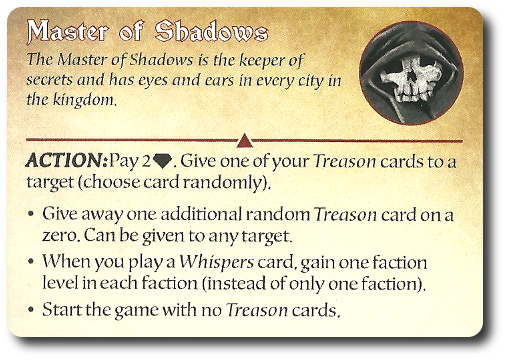
Each Character is unique; pick wisely
Third, each player collects the 4 Character tokens that match their Character placard and place 1 token on each of the “0” (zero) spaces of the 4 Faction tracks.
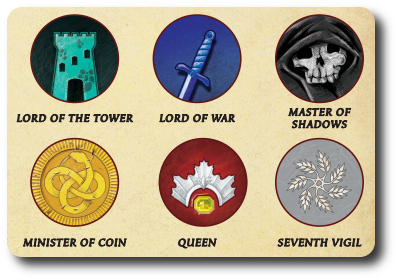
Fourth, shuffle the Faction cards and deal each player 5 cards, face-down. This is the player’s starting hand of cards. Players should pick them up and look at them, but keep them hidden until played. Place the remaining Faction cards face-down to create the Faction draw deck. Leave room for a discard pile.
Fifth, shuffle the Treason cards and deal 3 cards to each player, face-down. Players should look at these cards, but NOT add them to their hand. Players should place their Treason cards in a small pile next to their Character placard and keep them face-down. Place the remaining Treason cards face-down to create the Treason draw deck. Leave room for a discard pile.
Sixth, create a Bank for the Influence tokens by separating them by value. Note that each Influence token, regardless of value, all have the same image on one of their sides. The rules suggest placing the Influence tokens in the middle of the game board, but we found it easier to put each of the different Influence tokens values in their own separate cups. This allowed for quick exchanges and collection of tokens without the need to dig through them.
That’s it for game set up. Time to lie, scheme, and manipulate yourself to power…or to an early grave.
Of Puppets and Puppet Masters
Before the game can be played, it’s important to understand how the components are used to obtain influence, avoid suspicion, and manage the constant threat of being caught. The King may be weak, but his mind is sharp. He has decreed that any who are found (or suspected of) treason will be put to death. In order to win the throne, each player must be prepared to take risks, but not without first calculating how each move could lead closer to power or the axe.
The Characters
Each player selected a Character placard at the start of the game. These Characters are those closest to the King and the inner sanctum of the kingdom. They are also the ones stealing, plotting, manipulating, and threatening others to keep their place of power. They are dangerous, powerful, and capable of hurting as well as helping the kingdom. These Characters are not necessarily evil, but their methods are highly dubious. Each Character is unique and has their own pros and cons. The Characters are as follows:
- The Queen: Closest to the King, loved by the Peasants, and admired by the Nobles, the Queen outwardly shows support for her King, but has her own plans.
- The Lord of the Tower: Only concerned with the King’s safety, the Lord of the Tower knows that the kingdom’s future lies not with his frail liege.
- The Lord of War: Concerned only with the borders of the kingdom, the Lord of War believes that might makes right.
- Master of Shadows: Already a figure not to be trusted, the Master of Shadows is liked by few and feared by many.
- Minister of Coin: Gold moves commerce and commerce is the lifeblood of the kingdom, which the Minister of Coin knows how to stop.
- Seventh Vigil: Men and women of faith who pray for the kingdom’s safety and quietly whisper secret prayers of their own.
The Factions
While the Characters plot and plan, there are 4 powerful factions that hold a great deal of sway in the kingdom and its people. Earning the trust and allegiance of a faction promises a Character a great advantage. However, 1 faction is not enough to tip the scales in a Character’s favor. Each of the 4 factions are summarized here.
- The Noble Faction: Highborns, aristocrats, and ambitious lordlings make up this faction, all eager to please and to advance. The King himself can also be found among this rank, and even in his final days, he is still playing the political game at court.
- The Guild Faction: Artisans, craftsman, merchants, and commanders of great fleets that sail the seas, this faction’s primary concern is obtaining wealth and driving commerce. They see war and instability as a disruption, but also as a new opportunity.
- The Legion Faction: Sworn to protect, defend, and expand the kingdom, the Legion at first glance appears to be loyal soldiers. The truth is far more interesting. Soldiers they might be, but they are also tacticians and strategists. They know the wind does not blow in one direction forever and are more than willing to lend a hand to those who show great strength.
- The Peasant Faction: While they are not wealthy or powerful, they are the largest faction. The Peasant faction has their hands in all things and can often be found working within the protected wall of the other 3 factions, giving them access to a great deal of secrets. The Peasant faction protects their friends and goes out of their way to destroy their enemies.
The Faction cards represent the different actions, influence, and support each of the 4 different factions can provide. Their assistance will only be given to those who they consider friends and partners. Each Faction card will provide a trigger value (a number listed next to the faction’s symbol) that notes how much influence the Character must have with the faction for the card to be used fully. Players can use the help of all 4 factions during the game. This includes using the faction to help hide evidence and even construct buildings that can be used as bases of operation.
The Faction dice (with values 0, 1, 2, and 3) represent the 4 different factions’ inconsistent political agenda. Each faction is a powerhouse in their own right, owing allegiance to the King and kingdom, but seldom become directly involved in the politics of court. They are, nonetheless, players in this game of power mongering. Each game round calls for a new roll of the Faction dice, thus altering the amount of support, effects, power, and influence each faction provides.
Scattered within the Faction draw deck are the Whispers cards. Few in number, these events are the inevitable result of the growing intrigue at court. Rumors abound and soon reach a tipping point forcing Characters to take action, no matter how they personally feel about it. Game-wise, these cards trigger events that are automatically resolved. Theme-wise, the Characters have been caught up in their own subterfuge.
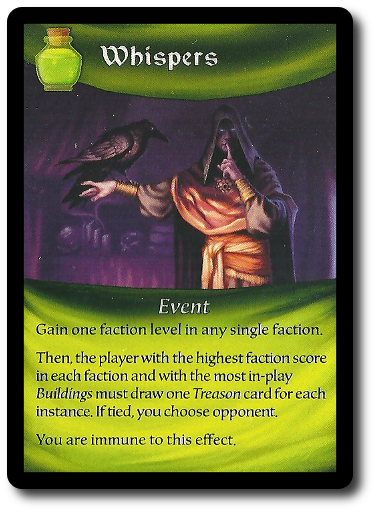
Treason and Influence
From the very start,the Characters are not trusted. Each player is given Treason cards before the game begins, hinting at their selected Character’s questionable history. Treason is the cost for earning influence. One cannot obtain the upper hand unless they go behind the King’s back. The thirst for power is strong enough to make even the most cautious man take questionable risks.
The Treason cards represent various poisons, bribes, hired spies, and planted rumors the Character is directly responsible for. They are, in many respects, damning evidence that clearly shows the Character’s true agenda. Each Treason card has a number value. When combined with the other Treason cards, the total value represents the Character’s overall treasonous activity. But in this game, you can be as treasonous as you like, as long as you are not the MOST treasonous. Lucky for all Characters, Treason cards and the evidence they represent, can be discreetly taken out of the picture.
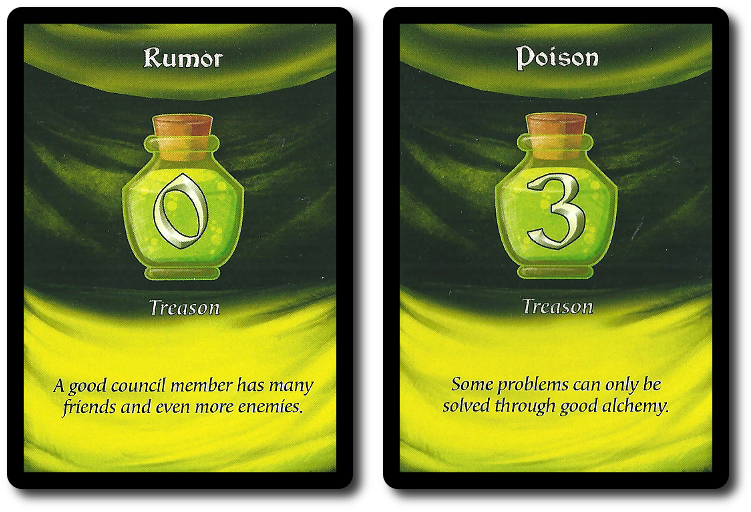
The Influence tokens look very much like coins and they should be seen as such. Influence is the wealthiest commodity in the game. Whichever Character has the most is certainly the most likely candidate to rule the kingdom and permanently remove perceived rivals. Influence can also be spent to persuade others to do things for the Characters. Like Treason cards, Influence is kept secret by the player by placing the Influence value face-down.
Politics, Power, and Certain Death
Council of Blackthorn is played in rounds and turns. There are not set number of rounds per game. During a single round, each player will be given 1 turn. A player’s turn is summarized here. The first player of every round is always the individual who currently has the Right Hand of the King token.
Step 1: Complete Building Construction
All “Building” Faction cards that were played during the player’s last turn are now complete. They are tilted so they are facing upright and can be used by the player during this turn. The “Building” Faction cards can be used like the cards in the player’s hand but are not discarded, as long as they meet the trigger’s requirements.
Step 2: Take an Action
The player can now take 1 action. The action to be used can be taken from a completed “Building” Faction cards or from their Character placard. Not all “Building” Faction cards or Character placards have actions. It’s therefore possible that a player may not have any actions to take until later in the game. If a player finds they are unable to take the actions necessary to secure their ownership of the throne, they should take steps to obtain that which they are missing.
Step 3: Play a Card
The player can now play 1 card from their hand. If the card played is a Whispers card, it’s automatically triggered and the effects are resolved before the game continues. The steps to resolve the Whispers card are completed by reading each line or block of text, from the top down. Whispers cards normally require players to account for their deeds and actions by counting Faction cards and faction influence. All of which is very visible to any other Character in the game. The player with the most of the noted card or has the highest value is rewarded for their efforts to overthrown the King by being given Treason cards. Once resolved, the card is discarded.
Whisper cards can be very damning, but there are so many more options to a player if they want to advance their own agenda or hurt an opponent. Such activities, however, require the help of the factions. If a card lists a Faction symbol and a number value, the player must have at least that much influence with the listed faction if the card is to be used for its effect. If the player cannot match it, they can still use the card.
The Faction die value for the matching Faction symbol now comes into play (not the number value next to it). The dice effects are always the first to be resolved before anything noted on the card can be triggered. The die value results are as follows:
- Zero (“blank”): The player does not gain any influence with the faction, but they are able to force an opponent to randomly draw 1 Treason card from them.
- One: The player gains 1 influence with the faction, moving their Character token to the next highest value in the Faction track.
- Two: The player gains 2 influence with the faction, moving their Character token to the next highest values in the Faction track twice.
- Three: The player gains 3 influence with the faction, moving their Character token to the next highest values in the Faction track thrice. Then the player draws 2 Treason cards from the Treason draw deck, adding them to any other Treason cards they have collected.
Multiple Character tokens can share the same space in a Faction track. The only exception is the Faction track “13” space. Only 1 Character token can claim this space and it goes to the first player who has earned the trust of the faction the fastest. Other players can continue to advance in that faction, but can never obtain anymore than the second highest faction influence value (in this case, a “9”). A player can, however, have their level of influence in a faction reduced by card effects. It’s therefor worthwhile for others to attempt to obtain the highest influence they can in hopes that the “13” space suddenly becomes vacant.
After the influence in the Faction track has been resolved using the die, the card text is then resolved, but only if the player has enough influence with the faction. Which they might have just earned. There are two types of Faction cards that can be played at this time. These are “Ally” and “Building” Faction cards. The Faction dice could be called for again within the card text, resulting in the text effects being resolved regardless of the player’s level of influence or completely ignored, even if the player practically owns the faction.
The “Ally” Faction card’s effects are read out loud, resolved, and then the Ally is discarded.
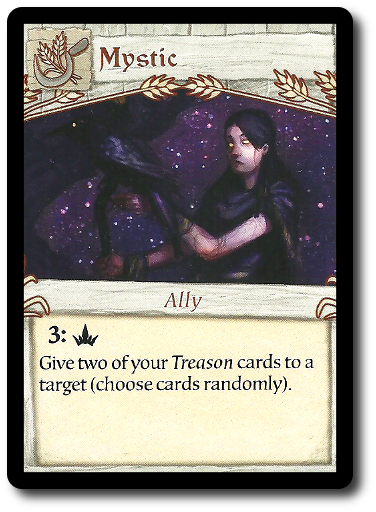
The “Building” Faction card is a bit more complicated. Once played, they are placed sideways and face-up. This is referred to as being “constructed” (although the Character really isn’t building anything). During the player’s next turn, they are “built” and can be used as part of step 1.
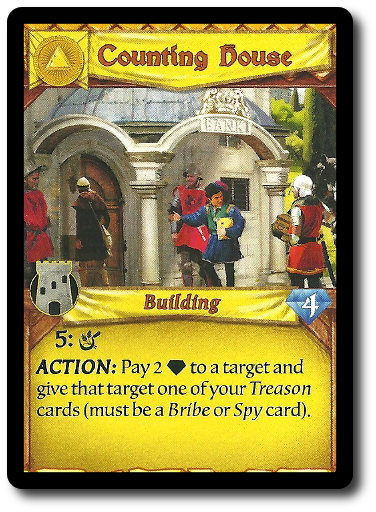
Step 4: Discard and Draw
The player may now discard 1 Faction card from their hand if they like, placing it face-up in the discard pile, and then draw back up to 5 cards using the Faction draw deck. A Character placard might suggest a different standard hand size, which should be used.
Step 5: Determine Control
The player now collects a number of Influence tokens based on their total level of control. The different Influence token values can and should be used to make different amounts. Tokens can be exchanged for larger and smaller values, but should always remain face-down in front of the player. The number of Influence tokens collected is determined as follows:
- Score 2 Influence for each faction the player has the highest influence with. This is noted on the Faction track. If tied with another opponent (and current value is above zero), the player only scores 1 Influence.
- Score 2 Influence if the player has the most in play (both built and under construction) “Building” Faction cards. If tied with another opponent, the player only scores 1 Influence.
This ends the player’s turn. The next player in turn order sequence now goes.
Another Day at Court Ends
After the last player has taken their turn, the round comes to an end. The Right Hand of the King token is passed to the next player in the turn order sequence and the Faction dice are re-rolled. A new round now begins starting with the Right Hand of the King.
A Throne Won, a Life Lost
The game continues until 3 Faction tracks have Character tokens in the “13” space at the end of any player’s turn. The round is completed and then the game immediately comes to an end, even if a Character token is removed from the “13” space during the round. The winner of the game is now determined, as well as the Character who has lost their head.
Step 1: Tally Influence
Influence comes from 3 different sources in the game.
- Add all Influence token values.
- Add the Faction space values for each of the player’s 4 Character tokens.
- Add the “Building” Faction card Building value for each built building in play the player controls and 2 Influence for any “Building” Faction cards under construction.
Step 2: Tally Treason
Obtaining power and influence under the nose of the King has earned the Characters a lot of enemies. The player’s Treason card values are now added, one player at a time, starting with the player with the fewest Influence. The total Treason value is announced and the player with the next highest Influence counts their Treason cards. The last player to count and announce their Treason card total value is the player with the most Influence.
Step 3: Off With Their Head
The player or players with the most Treason (as in a tie) are out of the game. Their Characters are taken to the King’s dungeon and executed. Their deeds, be they meant for the good of the kingdom and its people or for their own selfish ends have brought them low. Their names will be forever associated with the rest of the traitors and fools that have attempted to steal the throne.
Step 4: A Kingdom Won
The player with the highest Influence that has a Character still alive is the winner of the game and claims the throne. The kingdom is theirs, but before they begin the task of ruling, they might want to consider the remaining Characters in the game and how best to properly deal with them.
To learn more about Council of Blackthorn, visit the game publisher’s website or visit the Kickstarter campaign.
Final Word
The Child Geeks understood the concept of the game and the game play, but struggled at first to keep a balance between Influence and Treason earned. According to one Child Geek, “I know how to play this game. It’s not that hard. What I’m having trouble with is getting ride of the bad stuff.” Treason can come surprisingly easy, but so can Influence, and Influence is most often paired with treasonous activities. It’s a slippery slop the Child Geeks quickly found, slid on, and hit the bottom. Lesson learned. As one Child Geek put it, “I see now that the game is not about earning the most, but about balancing the best.” All but our youngest Child Geeks enjoyed the game, finding it to be fast, fun, and feisty. The majority of Child Geeks voted to approve Council of Blackthorn.
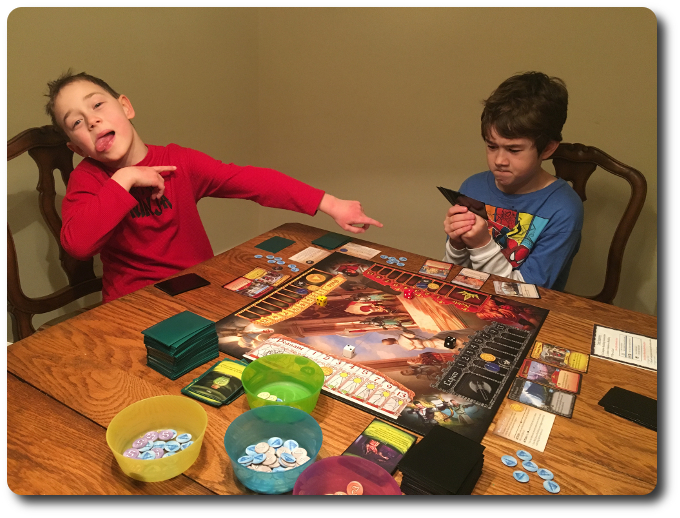
The Child Geeks liked to predict – over and over again – who among them would lose their head
The Parent Geeks found the game to be a mix of subtle intrigue and blatant backstabbing. According to one Parent Geek, “I cannot decide which part of the game I like more. The gaining of Influence or forcing my opponents to take my Treason cards for deeds they did not do.” They decided they liked both. The only aspect of the game they did not like was the inability to learn more about their opponents. According to one Parent Geek, “I don’t mind taking risks in a game, but I want the risks to be purposeful. I don’t know how much Treason or Influence my opponent has, so I don’t really know how much I should risk. It’s a bit annoying.” But only those players, apparently, who needed absolute assurances that their actions were justified. Everyone else just did everything they could within the defined limits of what they determined to be “just risky enough”. The final vote was a ringing endorsement from the Parent Geeks.
The Gamer Geeks are familiar with games where opponents are out to get them from the start. What they enjoyed most about the game was not knowing exactly who their biggest threat was. According to one Gamer Geek, “The reason I like this game so much? Easy. Everyone in this game is a threat. An enemy. Including myself. I have the ability to ensure I lose even when I think I’m playing the best.” The Gamer Geek brings up a great point. In this game, it’s not enough to be the best. You have to be the best and the least treacherous. That’s not easy. Another Gamer Geek said, “The game has a great mix of player interaction, strategy, tactics, and information. I’m really enjoying this.” All the Gamer Geeks voted to approve Council of Blackthorn, finding it to be a game that had just the right amount of wickedness to make them grin.
According to the game designer, one of the aspects of game play he wanted to capture was the intensity and danger of the Small Council in the George R. R. Martin’s A Song of Fire and Ice series that take place in a fantasy world full of intrigue and betrayal. I believe he captured such activities beautifully in the game without making each action taken by the players a harrowing event. Risk is most certainly felt in the game, but the lure of the reward out ways the danger. A player cannot help but push their own limits in hopes of winning. For those who enjoyed the political intrigued of Martin’s books, the game captures the constant shifting of power, the feverish attempt to influence, and the inevitable fall from favor.
I very much enjoyed this game for two reasons. First, it gives you a lot of information that lets you know where you opponents are going and what they are doing. The theme of the game is court intrigue, and I truly felt that I was seeing that very thing unfold in front of me. I saw allegiances move, power being taken, and lost. The thing is, I didn’t know enough to understand the opponent’s end game. Which brings me to my second reason. While the game provides a great deal of information, it also keeps a great deal invisible. I never really knew how powerful my opponents were, nor did I ever really know how bad off they were. Players must aggressively show the cards they play, but protectively hide the cards they keep. It created this fantastic air of mystery and intrigue.
The only issue I had with the game was that it was too short. Halfway through you start to do the math and realize your Character is about to be the next to visit the Executioner. Unless you are watching your numbers really closely and playing conservatively, it’s very easy to let things get out of control. The lure of power is very great in the game and the danger it inflict is hardly a concern until you start doing the math. It’s a lot like a credit card. You can spend and spend and spend, but it’s only when you get the bill you begin to realize how foolish your actions were.
My only nitpick is that the Queen, who is a Character owned by a player, is also an “Alley” Faction card. Which, I suppose makes sense if we consider that the Queen must always outwardly appear to be working for her King. However, it never really sat right with others and myself. We believed the Ally card for the Queen should be removed from play if the Character placard was in use. Which opened up the whole idea that there should be a special Ally type that is either in or out of the game based on the Character placards used. For example, the Master of Shadows as an “Ally” Faction card if not in use, or out if it was. Now that would be interesting.
I really enjoyed the scoring. You have to balance the good with the bad, but you can only get the good by taking the bad. Players have to watch their scales and keep them in balance as best as possible. It’s very easy to slide down a slope, but you can always march your way back up. What a player cannot control is time. The clock in the game is represented by the Faction tracks that advance the game in erratic bursts of sudden activity that cause everyone to pause and take account of their points. I found myself continually looking at cards, asking myself what it was worth, what it cost, and did I have the time to make it up. I didn’t think I did in many cases, but I still took the risk. After all, one of my opponents is surly taking more risk than me, right?
Games of political intrigue, power mongering, and subtle manipulation are difficult to design. Mostly because these three elements only seem to work well over a long period of time and involve a lot of plotting and planning. Council of Blackthorn has expertly captured the ups and downs of court intrigue and streamlined it in a game that plays surprisingly fast and takes no prisoners. The game is so fast, in fact, that many of our players were very surprised about how much Treason they had collected, focusing only on the Influence. Which, let’s be honest, is exactly what a power-hungry person would do. But such is the thinking of many who become obsessed with an idea and can no longer hear the voice of reason.
I am most pleased with Council of Blackthorn, finding it to be a game that challenged me to consider many different approaches to a hotly contested goal. Measuring the weight of the risks I was taking to the reward I was earning occupied my mind constantly as I attempted to navigate the ever-changing political battleground. There are no friends in this game, but you cannot outwardly make enemies. Each smile from an opponent was actually a murderous grin. I loved it and you might, too, if you don’t mind putting your neck on the line.
This is a paid for review of the game’s final prototype. Although our time and focus was financially compensated, our words are our own. We’d need at least 10 million dollars before we started saying what other people wanted. Such is the statuesque and legendary integrity of Father Geek which cannot be bought except by those who own their own private islands and small countries.



